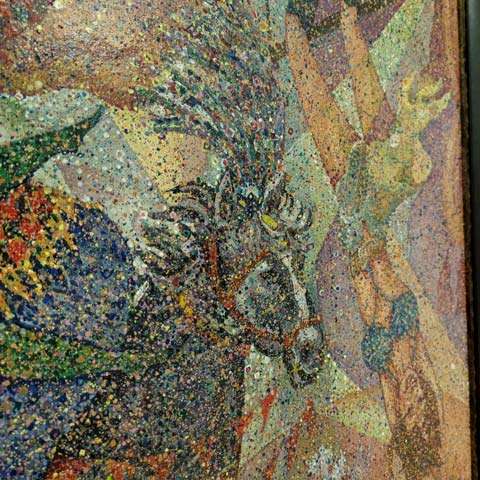
1960s UNOFFICIAL ART
KALININ Vyacheslav Vasilievich (1939) Clown on horseback and two acrobats. 2006–2007. Oil on canvas. 101 × 101
It's a case where everything is good: the name, the meter size, the inspiration. And the plot is positive, but without slurs, you could hang it in a nursery. No bummers, no merry drinking companions, just a clown and acrobats. The work was published in a thick bilingual catalogue, published in 2014.
Kalinin is an artist of the Lianozovo group, Nemukhin's neighbor in Priluki. Today he is a living legend of unofficial art, an original and recognizable artist, whose works are hunted by collectors. And in the 1960s, the authorities considered him a parasitic element, trying to get rid of him. Kalinin was expelled from the Abramtsevo school in 1961. His first exhibition at the Kurchatov Institute was closed almost immediately. In 1975, Kalinin was lucky to participate in the exhibition of unofficial artists in the pavilion “Beekeeping” at VDNKh. And soon after the authorities opened a “reservation” for independent artists in the “city committee” on Malaya Gruzinskaya 28. In the city committee Kalinin exhibited as part of the “seven” — a group of seven Moscow artists, which included Nemukhin, Kharitonov, Krasnopevtsev and others.
ZVEREV Anatoly Timofeevich (1931–1986) Crucifixion. 1958. Paper, gouache, whitewash, scratching, mixed media. 61 × 43
The most valuable year, the most valuable period, the tashist Zverev and a beautiful history of ownership in addition. On the back of this work there is an interesting inscription: “The work by Anatoly Zverev from the collection of my father G. D. Costakis to Savely Yamshchikov for good memory of my father, from Lily / signed by Aliki Kosta.. / Athens 11.11.02”. That is, it is a gift to the famous devotee, restorer and art historian Savva Yamshchikov. The drawing was in his collection for a long time and was published in the catalog of the exhibition “Museum of Friends. Collection of Savva Yamshchikov”on page 59.
RUSSIAN AVANT-GARDE
PORET Alisa Ivanovna (1902–1984) Portrait of Irina Miroshnichenko. 1965. Oil on canvas. 61 × 44.5
Alisa Poret was a student of Pavel Filonov, a member of his legendary group “Masters of Analytical Art”, co-author of Daniil Kharms' performances and even his fatal love. The artist miraculously survived the siege: her military brother received a letter from his dying family and managed to get them out of the besieged city. After the war Alisa Poret worked in Moscow, was engaged in book illustration. Children's books designed by her were especially popular. She illustrated poetry of Sergei Mikhalkov, fairy tales by Hoffmann, poems by Heinrich Sapgir. In the late 1950s and 1960s, Poret painted several portraits of friends from her youth (from photographs), including Kharms, and also made a series of portraits of her Moscow friends. Among them was Irina Miroshnichenko, a 23-year-old actress at the Moscow Art Theatre who had recently made her debut in Daneliya's film “I walk across Moscow”. Soon Miroshnichenko would be starring in Tarkovsky's “Andrei Rublev”, and much later in the films “You Never Dreamed of”, “Old New Year...” and others. Inspirational psychological portrait of the legendary actress from the legendary artist.
CONTEMPORARY ART
BELYAEV-GINTOVT Alexey Yurievich (1965) Philosophy of the Common Cause. 1987. Paper, author's technique. 97 × 65
Early Gintovt of 1987 is a great rarity. In 1988, the artist burned most of the works of the early period. It was a symbolic gesture, a ritual of renunciation of the past and transition to a new creative stage. The sheet “Philosophy of the Common Cause”, according to the author, survived only because by that time it already had a new owner. Gintovt of the 1980s is an artist of the group “Camouflage”, which invented extreme practices and created “art that should not be like art”. One of its members at that time was the mystical writer Viktor Pelevin. The members of the group were developing new coding systems. And things were complicated there. Sometimes works were destroyed, their memory was fixed on film, and in the end even the film itself was burned. Nothing was left behind. No wonder that “Camouflage” managed to disguise itself well and almost did not leave a trace in the history of art. And even the name “Camouflage” was almost erased. Because it too has changed to emphasize its conventionality and maintain the necessary secrecy.
But here we have a preserved conceptual work of Belyaev-Gintovt, and the author himself agreed to decipher its construct for us.
The crowd of people in the top row are workers whose outlines are borrowed from Soviet posters. A symbol of the hardworking people, the man of labor. Bottom right — St. Nicholas, revered national saint, symbol of the upper worlds. Bottom left — Arnold Schwarzenegger as Dutch from the movie “Predator”. With an assault rifle and underbarrel grenade launcher. For Gintovt, “Black Schwartz” is a symbol of the aggressive West. And all together, the heroes of his composition form a construction of the confrontation between “Eurasia” and “Atlantic” (the collective West) — becoming an illustration of planetary opposition. In fact, in 1987 Gintovt made a premonition project with a scenario of the conflict between Russia and the West, which was realized almost 30 years later. By the way, the artist is also present on this sheet. The figure with the bicycle — the observer — is just Gintovt himself, who at that time still signed with the double surname Belyaev-Gintovt.
- Log in to post comments










